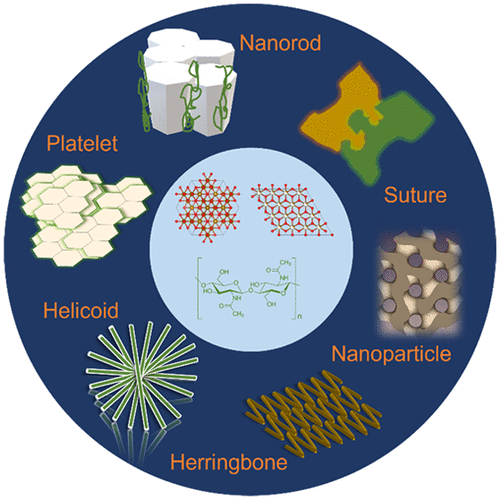当前位置:
X-MOL 学术
›
Acc. Chem. Res.
›
论文详情
Our official English website, www.x-mol.net, welcomes your feedback! (Note: you will need to create a separate account there.)
Nanoarchitected Tough Biological Composites from Assembled Chitinous Scaffolds
Accounts of Chemical Research ( IF 18.3 ) Pub Date : 2022-04-25 , DOI: 10.1021/acs.accounts.2c00110 Wei Huang 1 , Devis Montroni 2 , Taifeng Wang 3 , Satoshi Murata 4 , Atsushi Arakaki 4 , Michiko Nemoto 5 , David Kisailus 3
Accounts of Chemical Research ( IF 18.3 ) Pub Date : 2022-04-25 , DOI: 10.1021/acs.accounts.2c00110 Wei Huang 1 , Devis Montroni 2 , Taifeng Wang 3 , Satoshi Murata 4 , Atsushi Arakaki 4 , Michiko Nemoto 5 , David Kisailus 3
Affiliation

|
Over hundreds of millions of years, organisms have derived specific sets of traits in response to common selection pressures that serve as guideposts for optimal biological designs. A prime example is the evolution of toughened structures in disparate lineages within plants, invertebrates, and vertebrates. Extremely tough structures can function much like armor, battering rams, or reinforcements that enhance the ability of organisms to win competitions, find mates, acquire food, escape predation, and withstand high winds or turbulent flow. From an engineering perspective, biological solutions are intriguing because they must work in a multifunctional context. An organism rarely can be optimally designed for only one function or one environmental condition. Some of these natural systems have developed well-orchestrated strategies, exemplified in the biological tissues of numerous animal and plant species, to synthesize and construct materials from a limited selection of available starting materials. The resulting structures display multiscale architectures with incredible fidelity and often exhibit properties that are similar, and frequently superior, to mechanical properties exhibited by many engineered materials. These biological systems have accomplished this feat through the demonstrated ability to tune size, morphology, crystallinity, phase, and orientation of minerals under benign processing conditions (i.e., near-neutral pH, room temperature, etc.) by establishing controlled synthesis and hierarchical 3D assembly of nano- to microscaled building blocks. These systems utilize organic–inorganic interactions and carefully controlled microenvironments that enable kinetic control during the synthesis of inorganic structures. This controlled synthesis and assembly requires orchestration of mineral transport and nucleation. The underlying organic framework, often consisting of polysaccharides and polypeptides, in these composites is critical in the spatial and temporal regulation of these processes. In fact, the organic framework is used not only to provide transport networks for mineral precursors to nucleation sites but also to precisely guide the formation and phase development of minerals and significantly improve the mechanical performance of otherwise brittle materials.
中文翻译:

由组装的几丁质支架制成的纳米结构坚韧生物复合材料
数亿年来,生物体已经衍生出特定的特征集以响应共同的选择压力,这些压力可作为最佳生物设计的路标。一个典型的例子是植物、无脊椎动物和脊椎动物的不同谱系中强化结构的进化。极其坚韧的结构可以像盔甲、攻城锤或增强体一样发挥作用,增强生物体赢得比赛、寻找配偶、获取食物、逃避捕食以及抵御强风或湍流的能力。从工程的角度来看,生物解决方案很有趣,因为它们必须在多功能环境中工作。一个有机体很少能针对一种功能或一种环境条件进行优化设计。其中一些自然系统已经制定了精心策划的策略,以众多动植物物种的生物组织为例,从有限的可用起始材料中合成和构建材料。由此产生的结构显示出具有令人难以置信的保真度的多尺度结构,并且通常表现出与许多工程材料所表现出的机械性能相似且通常更优越的性能。这些生物系统通过建立受控合成和分层 3D,通过在良性加工条件(即接近中性 pH 值、室温等)下调节矿物的尺寸、形态、结晶度、相和取向的能力来实现这一壮举组装纳米到微米级的构件。这些系统利用有机-无机相互作用和精心控制的微环境,在无机结构合成过程中实现动力学控制。这种受控的合成和组装需要协调矿物运输和成核。这些复合材料中的底层有机框架通常由多糖和多肽组成,对这些过程的空间和时间调节至关重要。事实上,有机骨架不仅用于为矿物前体提供到成核位点的传输网络,还可以精确地指导矿物的形成和相发展,并显着提高脆性材料的机械性能。这种受控的合成和组装需要协调矿物运输和成核。这些复合材料中的底层有机框架通常由多糖和多肽组成,对这些过程的空间和时间调节至关重要。事实上,有机骨架不仅用于为矿物前体提供到成核位点的传输网络,还可以精确地指导矿物的形成和相发展,并显着提高脆性材料的机械性能。这种受控的合成和组装需要协调矿物运输和成核。这些复合材料中的底层有机框架通常由多糖和多肽组成,对这些过程的空间和时间调节至关重要。事实上,有机骨架不仅用于为矿物前体提供到成核位点的传输网络,还可以精确地指导矿物的形成和相发展,并显着提高脆性材料的机械性能。
更新日期:2022-04-25
中文翻译:

由组装的几丁质支架制成的纳米结构坚韧生物复合材料
数亿年来,生物体已经衍生出特定的特征集以响应共同的选择压力,这些压力可作为最佳生物设计的路标。一个典型的例子是植物、无脊椎动物和脊椎动物的不同谱系中强化结构的进化。极其坚韧的结构可以像盔甲、攻城锤或增强体一样发挥作用,增强生物体赢得比赛、寻找配偶、获取食物、逃避捕食以及抵御强风或湍流的能力。从工程的角度来看,生物解决方案很有趣,因为它们必须在多功能环境中工作。一个有机体很少能针对一种功能或一种环境条件进行优化设计。其中一些自然系统已经制定了精心策划的策略,以众多动植物物种的生物组织为例,从有限的可用起始材料中合成和构建材料。由此产生的结构显示出具有令人难以置信的保真度的多尺度结构,并且通常表现出与许多工程材料所表现出的机械性能相似且通常更优越的性能。这些生物系统通过建立受控合成和分层 3D,通过在良性加工条件(即接近中性 pH 值、室温等)下调节矿物的尺寸、形态、结晶度、相和取向的能力来实现这一壮举组装纳米到微米级的构件。这些系统利用有机-无机相互作用和精心控制的微环境,在无机结构合成过程中实现动力学控制。这种受控的合成和组装需要协调矿物运输和成核。这些复合材料中的底层有机框架通常由多糖和多肽组成,对这些过程的空间和时间调节至关重要。事实上,有机骨架不仅用于为矿物前体提供到成核位点的传输网络,还可以精确地指导矿物的形成和相发展,并显着提高脆性材料的机械性能。这种受控的合成和组装需要协调矿物运输和成核。这些复合材料中的底层有机框架通常由多糖和多肽组成,对这些过程的空间和时间调节至关重要。事实上,有机骨架不仅用于为矿物前体提供到成核位点的传输网络,还可以精确地指导矿物的形成和相发展,并显着提高脆性材料的机械性能。这种受控的合成和组装需要协调矿物运输和成核。这些复合材料中的底层有机框架通常由多糖和多肽组成,对这些过程的空间和时间调节至关重要。事实上,有机骨架不仅用于为矿物前体提供到成核位点的传输网络,还可以精确地指导矿物的形成和相发展,并显着提高脆性材料的机械性能。

























 京公网安备 11010802027423号
京公网安备 11010802027423号